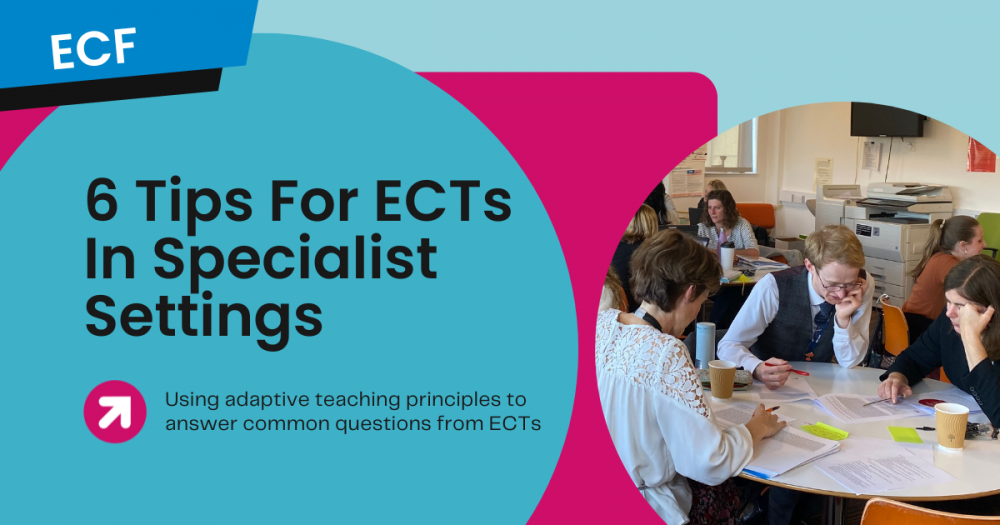6 Tips for ECTs in Specialist Settings

6 Tips for ECTs in Specialist Settings
Module 3 of the Early Career Framework (ECF) has an emphasis on adaptive teaching. Teachers working in a specialist setting will be teaching SEND pupils who require additional or adapted learning support. Because of this added need for support there are challenges presented to Early Career Teachers (ECTs). Many of these challenges will have an impact on outcomes for pupils, so it is important to tackle them with the correct approach. To help answer some common ECT questions, this NASEN case study shows how a teacher could approach each potential challenge.
How do I manage my TAs as a new teacher in a specialist setting?
One of the first things that took me by surprise when I began teaching in a special school was that suddenly I had a team of Teaching Assistants (TAs) that I was responsible for. I came from a mainstream school background, so suddenly having a team of TAs was relatively new territory.
What I found was that communication is key. Having a team meeting on a regular basis which allows for open discussion supports this. In the specialist settings I taught in, I often had between 1 and 4 additional adults within the room with between 8 to 12 young people. While having additional adults is vital for pupils with medical or personal hygiene issues, having other adults in the room can be challenging.
As a new teacher this can seem daunting at first, especially as I felt I was still developing my craft and I found that the teams I taught with were highly experienced. Each team had their own routines and ideas about what needed to happen in the classroom. It is important to be clear about roles and supporting this with effective communication. Make the effort to foster belonging by getting to know each TA individually. Establish routines and structures within the classroom in agreement with each of your TAs.
How do I ensure the TAs are ready for the lesson?
Supporting TAs is crucial, what made this even more challenging, was that I was teaching in a part primary-style class-based model and a part secondary-style model of moving every lesson. I was responsible for 15 TAs across my teaching week!
One of the key steps to this being successful was sharing the planning. It was not always possible for all of the TAs to read all of the planning, however those that were class-based often had the opportunity to set up the activities and resources ready for when I arrived.
In my own classroom, I established a routine for the pupils, that gave me two or three minutes to discuss the lesson with the TAs and their role, while they could relay any information about pupils to me. I ensured that my opening to the lesson informed the TAs as much as it informed the pupils about what was going to happen. I also had this on the board so everyone had something to refer back to.
I developed a classroom that supports questioning, from pupils and from other adults, in a supportive way. TAs were able to put their hand up and clarify what I was asking in a non-confrontational way that supported pupils’ understanding. Modelling questioning like this helps everyone to understand that there are no ‘stupid’ questions.
How do I utilise the TAs in my classroom?
You are responsible for everything that happens in your classroom, including the deployment of TAs. This is crucial to ensure that there are no ‘velcro’ TAs attaching themselves to the single child and developing ‘learned helplessness’ and stifling independence. I considered the different points within the lesson and planned for what I was expecting the TAs to do at each point. For example, if I wanted pupils to engage in circle time, I ensured that a TA was modelling expected behaviour, and another had been given the role of observing and making notes about the answers given and the effort made.
If I had a carousel of activities for TAs to support, I made sure they knew the role I wanted them to undertake at each station. If they were an observer, supporting joint attention, or scaffolding, then they needed to be fully aware of their role in this and what I would expect them to feedback to me. With clear expectations, supportive relationships, and effective communication you will form a team around the pupils who are all working towards the same goal.
How can I support my TAs to try something different?.png)
If you are coming into a very established team of TAs it can be challenging to try something new. I always made sure that I exemplified what the intention and aims were of bringing something new into the classroom and invited feedback and suggestions. This supported change, however in the rare times that consensus could not be reached I would acknowledge the feelings of the team whilst reminding them that I take full responsibility for any outcomes.
I have found that it is always better to take people along with you and establishing trust is crucial for this, as well as providing an opportunity for constructive feedback. Your team is only as good as your weakest member, remember to develop the team as you, the TAs and the pupils working together.
How can I make my TA team effective at what they do?
The key to working effectively is consistency, especially in communication and establishing routines. Before the first lesson with the pupils I communicate with the team what routines will be taught and establish the roles for staff and pupils. I often had routines for different tasks such as how to run a carousel of activities, how to transition to circle time and how feedback is going to be given. All of the logistics of the teaching day are made easier if the roles of other adults are clearly established. Teaching routines explicitly helps everyone in the room to be reminded of them and helps embed them over time. Continued consistency will ensure the team runs effectively.
How do I Work with the SENCO
In a specialist setting the SENCO has a slightly different undertaking than in a mainstream school, and there may not always be a ‘SENCO’. While they will monitor the register and support with plans, as a class teacher or subject specialist I was more involved with the Education, Health and Care Plan (EHCP) processes and attended annual reviews for the pupils in my form class. This was made easier by establishing with TAs a system of reporting back on the EHCP outcomes across the year for the pupils in my class. As I was not with my pupils all of the time, the TAs were my eyes and ears across the timetable and provided much evidence for the annual review reports. Within your induction and training you should spend time with the SENCO understanding these processes and your role within them.
Looking for more information?
If you would like any more information on our ECF programme, get in contact with us:
Email: enquiries@bestpracticenet.co.uk
Tel: +44 (0) 117 920 9200 (8.30am-5.30pm, Mon-Fri)


